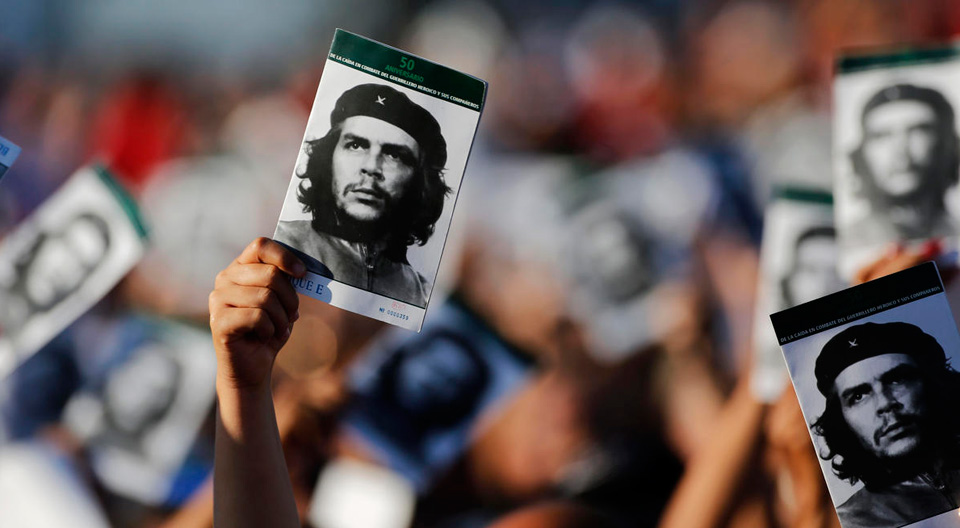
On October 9, 1967, socialist revolutionary and guerrilla leader Che Guevara, age 39, was killed by the Bolivian army. The U.S. military-backed Bolivian forces captured Guevara on October 8th while battling his band of guerrillas and assassinated him the following day. His hands were cut off as proof of death and his body was buried in an unmarked grave. In 1997, Guevara’s remains were found and sent back to Cuba, where they were reburied in a ceremony attended by President Fidel Castro and thousands of Cubans.
Ernesto Rafael Guevara de la Serna—familiarly known by the Argentinian slang word “Che,” meaning something like “hey, buddy”—was born to a comfortable family in Argentina in 1928. While studying medicine at the University of Buenos Aires, he traveled around South America on a motorcycle; during this time, he witnessed the poverty and oppression of the lower classes. He received a medical degree in 1953 and continued his travels around Latin America, becoming involved with left-wing organizations.
In the mid 1950s, Guevara met up with Fidel Castro and his group of exiled revolutionaries in Mexico. Guevara played a key role in Castro’s winning the guerrilla war against Cuban dictator Fulgencio Batista in 1959 and later served as one of Castro’s principal advisers, minister of industry, and international spokesperson. Guevara strongly opposed U.S. domination in Latin America and advocated peasant-based revolutions to combat social injustice in the underdeveloped world. Che famously called for “two, three, many Vietnams” to defeat imperialism. Castro later described him as “an artist of revolutionary warfare.”
Guevara resigned from his Cuban government post in April 1965, possibly over differences with Castro about the nation’s economic and foreign policies. Speculation continues to circulate about that split. Was he dismissed? Did he find the Cuban relationship with the USSR too constricting? Did he believe his work was done in Cuba and it was time to move on to other arenas? Was he drawn to the Trotskyist idea of “permanent revolution?”
Guevara soon turned up in the Congo with a small but highly trained group of mostly Afro-Cuban volunteers, and worked with Congolese guerrilla forces, trying to impart some of the ideological and tactical lessons learned in Cuba in a new context. Even with Cuban help, however, the organizational and leadership level of the insurgent forces was no match for the U.S.-funded Mobutu army and the white mercenaries. Thwarted, Che left Africa for Bolivia.
Guevara was taken alive in the village of Higueras, near the Ñancahuazú valley where he and his Bolivian and Cuban comrades had been trying to get a guerrilla operation going against the military dictatorship of General René Barrientos. Rumors and reports of the Cubans’ movements and location had been confirmed; in the end it was not difficult to surround and capture them on October 8th. Over the next several hours local Bolivian forces waited for instructions as to Guevara’s fate.
Former CIA operative Felix Rodriguez, a Cuban-American Vietnam veteran who fought in the Bay of Pigs invasion, took part in the manhunt for Guevara and remembered talking with him that night. In an interview with Newsmax, Rodriguez recalled that he asked why Guevara had selected Bolivia. “One,” said Che, “it was far away from the United States.” “Second,” Rodriguez remembered Che saying, “it was a very poor country so he didn’t feel that the United States would have that much interest in Bolivia, and third and most important to him, it had a boundary with five different countries”—Argentina, Paraguay, Brazil, Peru and Chile. A successful Bolivian revolution might have made it possible to expand the revolution into all those countries.
Barrientos, who was closely advised at every step by the C.I.A. and the Green Berets, gave the order to kill him without trial. On October 9, 1967, Che Guevara was shot without trial by Bolivian Sergeant Mario Terán. When he entered the room where Che was being held, Che said simply, “Shoot, coward, you are only going to kill a man.”
Following his death, Guevara became a worldwide iconic hero symbolizing anti-imperialism and revolution. A 1960 photo by Alberto Korda of Guevara in a beret continues to be replicated countless times on posters and T-shirts. A memorial to him in Santa Clara, Cuba, where his remains are interred, is a pilgrimage site for travelers from every land. Images of Che are ubiquitous in Cuba today, perhaps as a reminder of Fidel Castro’s wistful recollection, “We made the revolution we could, not the revolution we wanted.”
Few revolutionary thinkers today would endorse the guerrilla strategy Guevara tried to impose on Congo and Bolivia. National conditions are too differentiated for a single approach. But in his final gesture, still, Guevara is admired for his humanistic compassion with the downtrodden of the earth and his self-sacrificing spirit. Several Latin American countries, including Bolivia, have advanced politically by electoral means in the half century since Guevara died, many trying with some success to wrest their economies out from under the imperialist thumb.
In 2006, as a sign of Cuba’s magnanimity and goodwill, Mario Terán was treated for free, under a false name, for cataracts by Cuban physicians in the Cuba-Venezuela Operación Milagro (Operation Miracle) program, which restored his sight.
An interview with the CIA’s Felix Rodriguez can be found here, though given the source it should be read with caution.












Comments